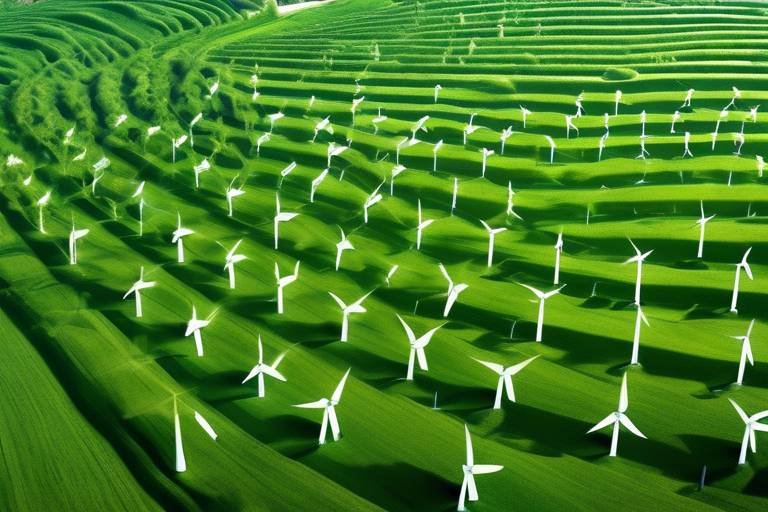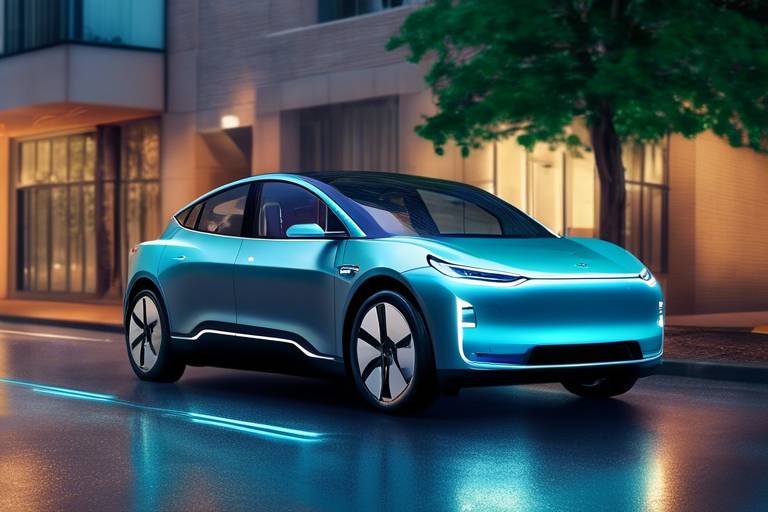Can AI Help Accelerate the Adoption of Green Energy?
In today’s rapidly evolving world, the urgency to transition to sustainable energy sources has never been more pressing. With the looming threat of climate change, we find ourselves at a crossroads where technology can either hinder or help our efforts. Enter artificial intelligence (AI), a game-changing force poised to revolutionize the green energy sector. But how exactly can AI facilitate this transition? This article explores the fascinating intersection of AI and green energy, shedding light on how these technologies can not only enhance efficiency but also drive the adoption of sustainable solutions.
Imagine a world where energy is not just consumed, but intelligently managed. Picture smart systems that predict energy needs, optimize production, and even reduce waste. This isn’t science fiction; it’s the potential reality offered by AI. From predicting energy demand to enhancing the efficiency of renewable sources, AI is set to play a pivotal role in reshaping our energy landscape.
As we delve deeper into this topic, we’ll uncover various aspects of how AI can be harnessed to accelerate the adoption of green energy. We’ll discuss its role in energy management, its ability to enhance renewable energy production, and the potential barriers to its implementation. With the right strategies, AI can be the catalyst that propels us towards a more sustainable future.
So, are you ready to explore how AI can transform the green energy sector? Let’s embark on this enlightening journey together!
Before we dive into the specifics of AI's role, it’s essential to grasp what green energy encompasses. Green energy refers to renewable energy sources that are environmentally friendly and sustainable. This includes solar, wind, hydroelectric, geothermal, and biomass energy. Each of these sources has its unique benefits and plays a crucial role in reducing our carbon footprint.
The importance of green energy cannot be overstated. As we face the adverse effects of climate change, transitioning to sustainable energy solutions is imperative. By utilizing renewable sources, we not only combat pollution but also promote energy independence and create job opportunities in emerging green sectors.
AI is becoming increasingly integral to optimizing energy management systems. With its ability to analyze vast amounts of data, AI algorithms can enhance energy distribution, minimize waste, and improve the efficiency of renewable energy sources. This leads to a more sustainable and reliable energy system.
One of the standout features of AI is its capability for predictive analytics. By forecasting energy consumption patterns, AI-driven models help energy providers anticipate demand fluctuations. This ensures a balanced supply of green energy, preventing shortages and overproduction. For instance, during peak usage times, AI can predict when energy demand will surge, allowing for timely adjustments in energy distribution.
Real-time monitoring systems powered by AI are revolutionizing how we track energy usage. These systems can provide immediate feedback, enabling proactive adjustments to enhance energy efficiency in homes and businesses. Imagine receiving alerts on your smartphone about your energy consumption, allowing you to make informed decisions to reduce waste. This level of control is not only empowering but also essential in our quest for sustainability.
Smart grids are another area where AI shines. By utilizing AI to manage energy flow, smart grids facilitate the integration of renewable sources into the existing energy infrastructure. This not only improves reliability but also reduces costs associated with energy distribution. In essence, AI transforms the grid into a dynamic, responsive system that can adapt to changing energy demands.
AI technologies can significantly boost renewable energy production. For example, AI can optimize the operation of solar panels by adjusting their angles to capture the maximum sunlight throughout the day. Similarly, in wind energy, AI can analyze weather patterns to determine the best times for turbine operation, maximizing output and efficiency.
Despite its potential, several barriers hinder the adoption of AI in green energy. Key challenges include high costs, data privacy concerns, and the need for skilled personnel. Understanding these obstacles is crucial for organizations looking to integrate AI into their green energy strategies.
The initial investment for AI technologies can be substantial. Organizations must evaluate the financial considerations involved in adopting AI solutions. However, it’s important to view this as a long-term investment that can yield significant returns through increased efficiency and reduced operational costs.
Data privacy is a critical concern in AI applications. As energy management systems collect vast amounts of data, ensuring its security is paramount. Organizations must implement robust security measures to mitigate risks associated with data breaches and unauthorized access.
The future of AI in green energy is promising. As technology continues to advance, we can expect a wave of innovations that will further enhance the efficiency and reliability of renewable energy sources. From improved predictive analytics to smarter grids, the possibilities are endless. The impact of AI on the global energy landscape could be transformative, leading us toward a more sustainable and resilient future.
- What is green energy? Green energy refers to renewable energy sources that are environmentally friendly, such as solar, wind, and hydroelectric power.
- How does AI improve energy management? AI enhances energy management by optimizing distribution, predicting demand, and enabling real-time monitoring.
- What are the barriers to AI adoption in green energy? Key barriers include high costs, data privacy concerns, and the need for skilled personnel.
- What is the future outlook for AI in green energy? The future is bright, with expected innovations that will enhance efficiency and reliability in the sector.

Understanding Green Energy
Green energy refers to renewable energy sources that are not only sustainable but also environmentally friendly. These sources play a critical role in our ongoing battle against climate change, reducing our reliance on fossil fuels, and promoting a healthier planet. Imagine a world where the air is clean, the oceans are vibrant, and the energy we consume does not contribute to the degradation of our environment. This is the promise of green energy, and it’s becoming increasingly vital as we face the harsh realities of climate change.
There are several types of green energy, each with its unique benefits and challenges. The most common sources include:
- Solar Energy: Harnessed from the sun, solar energy is captured using photovoltaic cells and can be utilized for everything from powering homes to fueling electric vehicles.
- Wind Energy: Generated by wind turbines, this form of energy is one of the fastest-growing renewable sources, converting kinetic energy from wind into electricity.
- Hydropower: Utilizing the flow of water, hydropower is one of the oldest forms of renewable energy and is particularly effective in areas with abundant water resources.
- Geothermal Energy: This energy comes from the heat stored beneath the Earth's surface and can be used for heating buildings or generating electricity.
- Biomass: Derived from organic materials, biomass energy can be produced from anything from plant materials to animal waste, providing a sustainable alternative to fossil fuels.
Each of these energy sources contributes to a more sustainable future, but they also come with their own sets of challenges. For instance, solar energy production can be inconsistent due to weather conditions, while wind energy relies heavily on geographical locations. However, the potential benefits far outweigh these challenges. By investing in green energy, we can significantly reduce greenhouse gas emissions, create jobs in new industries, and promote energy independence.
Furthermore, the importance of green energy extends beyond just environmental benefits. It also has significant economic implications. Transitioning to renewable energy can lead to lower energy bills for consumers, create new job opportunities in the green tech sector, and stimulate local economies. As we continue to innovate and improve our technologies, the cost of harnessing these renewable resources is steadily decreasing, making green energy more accessible than ever.
In summary, understanding green energy is crucial for anyone interested in the future of our planet. It encompasses a range of renewable sources that not only help combat climate change but also offer economic advantages. As we delve deeper into the role of AI in enhancing these energy sources, it becomes clear that the future is bright for both technology and sustainability.

The Role of AI in Energy Management
In today's rapidly evolving energy landscape, artificial intelligence (AI) is emerging as a game changer in energy management. Imagine having a system that not only predicts how much energy you will need but also optimizes the way that energy is distributed. Sounds futuristic, right? Well, it's happening right now! AI technologies are being integrated into energy management systems to enhance efficiency, reduce waste, and ensure that renewable energy sources are utilized to their fullest potential.
One of the most significant advantages of AI in energy management is its ability to analyze vast amounts of data in real-time. This capability allows for improved decision-making and operational efficiency. For instance, AI algorithms can assess energy consumption patterns and identify inefficiencies that would be nearly impossible for humans to detect. By leveraging this technology, energy providers can create a more responsive and sustainable energy ecosystem.
Moreover, AI plays a pivotal role in energy distribution. It can predict energy demand and supply fluctuations, which is essential for maintaining a stable energy grid. By using predictive analytics, AI systems can forecast spikes in energy demand, allowing providers to adjust their output accordingly. This not only helps in balancing the grid but also minimizes the reliance on fossil fuels during peak times, thereby promoting green energy solutions.
Predictive analytics is like having a crystal ball for energy consumption. By utilizing historical data, AI-driven models can forecast future energy needs with remarkable accuracy. This capability is crucial for energy providers as it allows them to plan their production schedules effectively. Imagine a scenario where a utility company can anticipate a surge in energy demand on a hot summer day; they can ramp up production from renewable sources like solar or wind before the demand hits. This proactive approach not only enhances efficiency but also reduces the strain on the grid.
Another exciting aspect of AI in energy management is real-time monitoring. With AI-powered systems, energy usage can be tracked continuously, providing insights that lead to immediate adjustments. For instance, if a factory is using more energy than planned, the system can automatically reduce power to non-essential equipment, helping to conserve energy and cut costs. This dynamic control mechanism is essential for both homes and businesses, enabling them to operate more sustainably.
The integration of AI with smart grids is revolutionizing how energy is managed. Smart grids utilize AI algorithms to manage energy flow, making it easier to incorporate renewable sources into the grid. This not only improves reliability but also significantly reduces operational costs. For example, when solar energy production peaks during the day, AI can manage the distribution of that energy to where it’s needed most, ensuring that no energy goes to waste.
In summary, the role of AI in energy management is multifaceted and transformative. By optimizing energy distribution, predicting demand, and enabling real-time monitoring, AI is paving the way for a more efficient and sustainable energy future. As we continue to embrace these technologies, the potential for a greener planet becomes increasingly attainable.
- How does AI improve energy efficiency? AI improves energy efficiency by analyzing data to optimize energy distribution and predict demand, thus reducing waste.
- What are smart grids? Smart grids are advanced electrical grids that use AI and digital technology to manage energy flow more efficiently.
- Can AI help in integrating renewable energy sources? Yes, AI plays a crucial role in managing the flow of renewable energy, ensuring that it is effectively utilized within the energy grid.

Predictive Analytics for Energy Demand
Predictive analytics is like having a crystal ball for energy consumption. Imagine being able to foresee how much energy your home or business will need tomorrow, next week, or even next year! This is where artificial intelligence (AI) steps in, transforming raw data into actionable insights. By leveraging historical data, weather patterns, and consumption trends, AI-driven models can accurately forecast energy demand, allowing providers to adjust their supply accordingly. This not only ensures that energy is available when it’s needed most but also helps in minimizing waste.
One of the remarkable aspects of predictive analytics is its ability to analyze vast amounts of data in real-time. For instance, energy companies can utilize AI algorithms to sift through data from smart meters, social media trends, and even local events to predict spikes in energy usage. This means that during hot summer days when air conditioners are running full blast, energy providers can prepare in advance, ensuring that the grid remains stable and reliable.
Furthermore, predictive analytics can also play a significant role in integrating renewable energy sources into the energy mix. For example, solar and wind energy production can be unpredictable due to weather conditions. By analyzing weather forecasts and historical production data, AI can help energy providers predict how much renewable energy will be available at any given time. This allows for better planning and a more balanced energy supply, reducing reliance on fossil fuels and enhancing sustainability.
To illustrate this further, consider the following table that outlines the benefits of using predictive analytics in energy demand forecasting:
| Benefit | Description |
|---|---|
| Enhanced Efficiency | Optimizes energy distribution and reduces waste. |
| Cost Savings | Reduces operational costs by predicting demand accurately. |
| Improved Reliability | Ensures a stable energy supply, even during peak demand. |
| Integration of Renewables | Facilitates the use of renewable energy sources by predicting availability. |
In summary, predictive analytics is revolutionizing the way energy providers manage supply and demand. By embracing AI technologies, they can not only enhance operational efficiency but also contribute to a greener, more sustainable future. As we continue to face challenges related to energy consumption and climate change, the role of predictive analytics will only become more crucial in ensuring that we have a reliable and sustainable energy system.
- What is predictive analytics in energy management?
Predictive analytics involves using AI and historical data to forecast future energy consumption patterns, helping energy providers optimize their supply. - How does predictive analytics benefit renewable energy?
It helps in predicting the availability of renewable sources like solar and wind, allowing for better integration into the energy grid. - Can predictive analytics reduce energy costs?
Yes, by optimizing energy distribution and reducing waste, predictive analytics can lead to significant cost savings for energy providers.

Real-time Monitoring and Control
In today's fast-paced world, the need for systems in energy management has never been more crucial. Imagine a world where energy consumption is not just tracked but optimized in real-time, ensuring that every watt is used efficiently. This is where artificial intelligence (AI) steps in, acting as the brain behind sophisticated energy management systems.
AI-driven real-time monitoring systems can analyze data from various sources, such as smart meters and IoT devices, to provide insights into energy usage patterns. By utilizing advanced algorithms, these systems can detect anomalies, predict energy surges, and even suggest actionable steps to mitigate waste. For instance, if a home or business is consuming more energy than usual, the AI can alert the user and recommend adjustments, such as reducing usage during peak hours or switching to energy-efficient appliances.
Moreover, the integration of AI in real-time monitoring allows for proactive adjustments. This means that instead of reacting to energy inefficiencies after they occur, businesses and homeowners can take steps to prevent them in the first place. For example, consider a commercial building equipped with a smart HVAC system. The AI can monitor temperature settings, occupancy levels, and even weather forecasts to optimize heating and cooling, ensuring comfort while minimizing energy consumption.
Another fascinating aspect of real-time monitoring is its ability to facilitate demand response programs. These programs incentivize consumers to reduce or shift their energy usage during peak demand times. With AI, energy providers can communicate directly with consumers, providing real-time data on energy prices and demand levels. This dynamic interaction not only helps balance the grid but also allows consumers to save money by adjusting their energy use in response to real-time conditions.
As we delve deeper into the capabilities of AI in real-time monitoring, it's essential to consider the technology's user-friendly interfaces. Many systems now come equipped with intuitive dashboards that display energy usage in a visually appealing and understandable manner. Users can easily track their consumption patterns, set energy-saving goals, and even receive personalized recommendations based on their unique usage habits. This democratization of energy data empowers consumers to take charge of their energy consumption.
In summary, the role of AI in real-time monitoring and control is transforming how we manage energy. The capability to analyze vast amounts of data instantaneously and provide actionable insights is paving the way for a more efficient and sustainable energy landscape. As we continue to innovate and improve these systems, the potential for energy savings and environmental benefits will only grow, making AI an indispensable tool in the quest for a greener future.
- What is real-time monitoring in energy management? Real-time monitoring involves tracking energy usage as it happens, allowing for immediate adjustments and optimizations.
- How does AI improve energy efficiency? AI analyzes data to identify patterns, predict demand, and suggest proactive measures to reduce energy waste.
- Can real-time monitoring help me save money on my energy bill? Yes, by adjusting your energy usage based on real-time data, you can take advantage of lower rates and reduce unnecessary consumption.
- What technologies are involved in real-time monitoring? Technologies include smart meters, IoT devices, and AI algorithms that work together to provide insights into energy consumption.

Integration of Smart Grids
The concept of smart grids represents a revolutionary shift in how we manage and distribute energy. Imagine a power system that not only delivers electricity but also communicates with consumers and energy producers in real-time. This is where artificial intelligence (AI) steps in, playing a pivotal role in transforming traditional grids into smart, responsive networks. By leveraging AI, smart grids can optimize energy flow, integrate renewable sources, and enhance overall efficiency.
One of the most significant advantages of integrating AI into smart grids is the ability to manage energy demand dynamically. Through sophisticated algorithms, these grids can analyze consumption patterns and predict peak usage times. This means that during high-demand periods, the system can automatically adjust the energy supply, ensuring stability and minimizing the risk of blackouts. For instance, if a sudden spike in electricity usage is detected, AI can quickly reroute power from less busy areas or activate backup renewable sources, such as solar or wind energy, to meet the demand.
Moreover, smart grids equipped with AI technologies facilitate the seamless integration of various renewable energy sources. Unlike traditional grids, which often struggle to accommodate fluctuating energy inputs from solar panels and wind turbines, smart grids can intelligently balance these inputs. They utilize real-time data to forecast energy production and adjust the distribution accordingly. This not only maximizes the use of clean energy but also reduces reliance on fossil fuels, contributing to a more sustainable energy ecosystem.
Another key feature of AI-enhanced smart grids is their ability to monitor and manage energy usage at a granular level. Through advanced sensors and IoT devices, these grids collect data from homes and businesses, providing insights into energy consumption trends. This data can be invaluable for consumers looking to reduce their energy bills. By having access to real-time information, users can make informed decisions about their energy usage, such as running appliances during off-peak hours when electricity rates are lower.
Furthermore, the integration of smart grids can lead to significant cost savings for both utilities and consumers. By optimizing energy distribution and reducing waste, smart grids can lower operational costs. This is particularly important as the world shifts towards more complex energy systems that incorporate a diverse mix of generation sources. The table below illustrates the potential cost benefits associated with smart grid implementation:
| Cost Factor | Traditional Grid | Smart Grid |
|---|---|---|
| Operational Costs | High | Reduced by 20-30% |
| Energy Losses | 15-20% | 5-10% |
| Customer Satisfaction | Moderate | High |
In conclusion, the integration of AI into smart grids is not just a technological advancement; it is a crucial step towards a sustainable energy future. By enhancing energy management, improving efficiency, and promoting the use of renewable energy sources, smart grids pave the way for a cleaner and more resilient energy landscape. As we continue to embrace these innovations, we move closer to a world where green energy is not just an option but a standard.
- What is a smart grid? A smart grid is an electricity supply network that uses digital technology to monitor and manage the transport of electricity from all generation sources to meet the varying electricity demands of end users.
- How does AI improve smart grids? AI enhances smart grids by optimizing energy distribution, predicting demand, and integrating renewable energy sources more effectively.
- What are the benefits of using smart grids? Benefits include reduced operational costs, improved energy efficiency, enhanced reliability, and increased customer satisfaction.

Enhancing Renewable Energy Production
When we think about renewable energy, the first things that come to mind are solar panels soaking up the sun’s rays and wind turbines spinning gracefully in the breeze. But what if I told you that artificial intelligence (AI) is the secret sauce that can elevate these technologies to new heights? Indeed, AI is revolutionizing the way we harness and optimize renewable energy, making it more efficient and effective than ever before. Imagine being able to predict the best times to generate energy based on weather forecasts or even adjusting the angle of solar panels in real-time to capture the maximum sunlight. Sounds like science fiction, right? Well, it’s happening right now!
One of the most compelling ways AI enhances renewable energy production is through optimization algorithms. These smart systems analyze vast amounts of data from various sources, such as weather patterns, energy demand, and equipment performance. By processing this information, AI can suggest the most efficient configurations for solar panels and wind turbines. For instance, AI can determine the optimal tilt angle for solar panels throughout the day, ensuring they capture the most sunlight. This not only maximizes energy production but also significantly reduces operational costs.
Furthermore, AI plays a pivotal role in predictive maintenance. By continuously monitoring the performance of renewable energy systems, AI can identify potential issues before they escalate into costly failures. This proactive approach allows for timely repairs and maintenance, ensuring that wind turbines and solar panels operate at peak performance. In fact, studies have shown that predictive maintenance can reduce downtime by as much as 30%!
But how does this translate to actual energy production? Let’s take a look at a few key statistics:
| Technology | Efficiency Improvement | Cost Reduction |
|---|---|---|
| Solar Panels | Up to 20% | 15% reduction in operational costs |
| Wind Turbines | 15% increase in output | 20% reduction in maintenance costs |
In addition to optimizing existing systems, AI also opens the door to new forms of renewable energy production. For example, innovative AI-driven technologies are being used in energy storage solutions. These systems can predict energy production and consumption patterns, allowing for better management of energy storage, which is crucial for balancing supply and demand. Imagine a world where excess energy generated during sunny days is stored and used on cloudy days or during peak hours. This not only stabilizes the grid but also enhances the reliability of renewable energy sources.
Moreover, AI can facilitate the integration of distributed energy resources (DERs), such as home solar systems and electric vehicles, into the larger energy grid. By managing these resources intelligently, AI can ensure that energy flows seamlessly between producers and consumers, making the entire system more resilient and efficient. This interconnectedness is essential for a sustainable energy future, where every bit of energy produced counts.
In conclusion, the intersection of AI and renewable energy production is a game-changer. By optimizing performance, predicting maintenance needs, and enabling the integration of diverse energy sources, AI is not just enhancing renewable energy production; it is paving the way for a sustainable future. As we continue to embrace these technologies, the transition to a greener planet becomes not just a dream but a tangible reality.
- How does AI improve solar panel efficiency? AI algorithms analyze weather data and optimize the angle and position of solar panels to maximize sunlight capture.
- What role does predictive maintenance play in renewable energy? It helps prevent equipment failures by monitoring performance and identifying issues before they become serious problems.
- Can AI help with energy storage solutions? Yes, AI can predict energy production and consumption, allowing for better management of stored energy to balance supply and demand.

Barriers to AI Adoption in Green Energy
As promising as the integration of artificial intelligence (AI) into the green energy sector appears, there are several significant barriers that can impede its adoption. These challenges can be likened to hurdles in a race—each one must be overcome to reach the finish line of a sustainable energy future. Let's dive into some of the most pressing issues that organizations face.
One of the primary hurdles is the high cost of implementation. Integrating AI technologies requires a substantial upfront investment. Organizations must consider not only the cost of the AI systems themselves but also the expenses associated with necessary infrastructure upgrades and ongoing maintenance. For many companies, especially smaller ones, these costs can be daunting. In fact, a recent study found that 60% of businesses cited financial constraints as a major barrier to adopting AI in their operations.
Moreover, the integration of AI into energy systems raises data privacy and security concerns. With the increasing reliance on data-driven decision-making, sensitive information about energy usage and consumer behavior is collected and analyzed. This creates a potential target for cyberattacks, which can compromise both consumer trust and the integrity of energy management systems. Companies must navigate the complex landscape of data regulations and implement robust security measures to protect this information. The challenge lies not only in securing data but also in ensuring compliance with regulations such as GDPR, which can vary by region.
Another significant barrier is the need for skilled personnel. The rapid pace of technological advancement means that there is a growing demand for professionals who are not only familiar with AI but also understand its application in the energy sector. Unfortunately, there is currently a shortage of qualified individuals who possess the necessary skills to implement and manage AI solutions effectively. This gap in expertise can slow down the adoption of AI technologies, as organizations may struggle to find the right talent to drive their initiatives forward.
In addition to these challenges, the lack of standardization in AI technologies can create confusion and hesitation among potential adopters. Different AI solutions may not be compatible with existing systems, leading to integration difficulties that can deter organizations from making the leap. Without a clear framework or set of standards, companies may be reluctant to invest in AI, fearing that they will face additional obstacles down the line.
Lastly, there is often a cultural resistance to change within organizations. Many businesses have established processes and systems that have been in place for years, and introducing AI can be met with skepticism. Employees may fear job displacement or be hesitant to adopt new technologies, preferring the familiarity of traditional methods. Overcoming this resistance requires not only effective change management strategies but also a commitment to educating and involving staff throughout the transition process.
In summary, while the potential for AI to revolutionize the green energy sector is immense, organizations must navigate a series of barriers to fully realize its benefits. Addressing these challenges will require a concerted effort from stakeholders across the industry, including investment in training, robust data security measures, and a commitment to fostering a culture of innovation and adaptability.
- What are the main barriers to AI adoption in green energy?
The main barriers include high implementation costs, data privacy concerns, a shortage of skilled personnel, lack of standardization, and cultural resistance to change. - How can organizations overcome the financial barriers to AI?
Organizations can explore partnerships, seek government grants, or invest in phased implementations to spread out costs. - What role does data security play in AI adoption?
Data security is crucial as it protects sensitive information from cyber threats, ensuring consumer trust and compliance with regulations.

Cost Implications
When it comes to integrating AI technologies into green energy strategies, one of the most significant hurdles organizations face is the initial investment. The costs associated with implementing AI can be substantial, and this often raises questions about the return on investment (ROI) and the overall financial viability of such projects. Many companies find themselves at a crossroads, weighing the immediate financial implications against long-term benefits. It's a bit like buying a high-end electric vehicle; the upfront cost might be steep, but the savings on fuel and maintenance can pay off in the long run.
To better understand the financial landscape, it's essential to consider several key factors that contribute to the overall cost of AI adoption in green energy:
- Infrastructure Upgrades: Implementing AI often requires significant upgrades to existing infrastructure. This includes the installation of advanced sensors, data collection systems, and improved computing resources.
- Software Development: Custom AI solutions may be necessary, which means organizations will need to invest in software development or purchase off-the-shelf solutions tailored to their needs.
- Training and Development: Staff must be trained to work with new AI systems, which can involve additional costs related to hiring experts or providing ongoing education for existing employees.
While these costs can be daunting, it's crucial to evaluate them in the context of potential savings and efficiency gains. For instance, AI can optimize energy production and consumption, leading to reduced operational costs over time. A recent study showed that organizations that implemented AI in their energy management systems saw an average 15-20% reduction in energy costs. This statistic is not just a number; it represents real savings that can be reinvested into further innovations or sustainability initiatives.
Moreover, as the technology matures and becomes more widespread, the costs associated with AI adoption are expected to decrease. Just like the evolution of smartphones, the initial high costs eventually give way to more affordable options as competition increases and technology becomes more accessible. In this regard, organizations must be forward-thinking and consider the long-term benefits of investing in AI for green energy, rather than solely focusing on the initial expenditures.
In conclusion, while the cost implications of adopting AI in green energy can be significant, the potential for enhanced efficiency, reduced operational costs, and long-term sustainability far outweighs the initial investments. Organizations that embrace this technology will not only contribute to a greener planet but also position themselves as leaders in a rapidly evolving energy landscape.
- What are the primary costs associated with AI adoption in green energy?
Organizations typically face costs related to infrastructure upgrades, software development, and training personnel. - How can AI reduce energy costs?
AI optimizes energy production and consumption, leading to significant savings over time. - Is the initial investment in AI worth it?
While the upfront costs can be high, the long-term benefits such as reduced operational costs and improved efficiency often justify the investment.

Data Privacy and Security
In an age where data is often referred to as the new oil, the intersection of artificial intelligence (AI) and green energy raises significant concerns regarding data privacy and security. As AI technologies gather and analyze vast amounts of data to optimize energy management systems, the question looms large: how do we protect sensitive information while harnessing the full potential of these innovations? The energy sector is not only responsible for powering our homes and businesses but also for safeguarding the personal and operational data of consumers and organizations alike.
One of the primary challenges in this arena is that AI systems require access to extensive datasets to function effectively. These datasets often include sensitive information such as energy consumption patterns, personal preferences, and even geographic locations. If mishandled or inadequately protected, this data can become a target for cybercriminals, leading to potential breaches that could compromise not just individual privacy but also the operational integrity of energy providers. As such, implementing robust data security measures is not just a regulatory requirement but a moral imperative.
To mitigate these risks, energy providers must adopt a multi-faceted approach to data privacy and security. Here are some key strategies they can implement:
- Data Encryption: Encrypting sensitive data ensures that even if it is intercepted, it remains unreadable and secure.
- Access Controls: Implementing strict access controls helps ensure that only authorized personnel can access sensitive information.
- Regular Audits: Conducting regular security audits can help identify vulnerabilities and ensure compliance with data protection regulations.
- Employee Training: Training employees on data privacy best practices is crucial, as human error can often lead to security breaches.
Furthermore, regulatory frameworks such as the General Data Protection Regulation (GDPR) in Europe and various data protection laws in other regions play a critical role in shaping how organizations handle data. These regulations not only impose strict guidelines on data collection and usage but also empower consumers with rights over their personal information. Compliance with these regulations is essential for building trust with consumers, who are increasingly aware of their data rights and the potential risks associated with data misuse.
As AI continues to evolve and integrate into the green energy sector, the emphasis on data privacy and security will only intensify. Energy providers must remain vigilant and proactive, adopting cutting-edge security technologies and practices to protect their systems and customers. The future of green energy and AI can be bright, but it hinges on our ability to navigate the complex landscape of data privacy and security effectively.
- What are the main data privacy concerns in AI and green energy? The primary concerns include unauthorized access to sensitive information, data breaches, and compliance with data protection regulations.
- How can energy providers ensure data security? By implementing encryption, access controls, regular audits, and employee training, energy providers can significantly enhance their data security measures.
- What role do regulations play in data privacy? Regulations like GDPR set strict guidelines for data handling, ensuring that organizations protect consumer data and respect individual privacy rights.

The Future of AI and Green Energy
The future of AI in green energy is not just a fleeting trend; it is a revolution that is set to redefine how we produce and consume energy. As we stand on the brink of a new era, the integration of artificial intelligence into the renewable energy sector promises to enhance efficiency, reduce costs, and significantly mitigate environmental impacts. Imagine a world where energy systems are not only smart but also self-optimizing, adjusting in real-time to meet the demands of users while maximizing the use of renewable resources. This is not science fiction—this is our impending reality.
One of the most exciting prospects is the development of autonomous energy systems. These systems will leverage AI to analyze vast amounts of data from solar panels, wind turbines, and other renewable sources. By doing so, they can predict energy production levels and adjust accordingly. For instance, if a storm is forecasted, these systems can preemptively reduce energy output to prevent overloads. This kind of adaptability will not only enhance the reliability of renewable energy but also make it more appealing to consumers and businesses alike.
Furthermore, as AI technologies continue to evolve, we can expect to see advancements in energy storage solutions. With the rise of electric vehicles and the increasing demand for energy during peak hours, efficient storage systems are critical. AI can optimize battery management systems, ensuring that energy is stored and distributed effectively. This will facilitate a smoother transition to renewable energy sources and help balance the grid, making green energy more accessible and reliable for everyone.
Another significant development on the horizon is the enhancement of smart cities. These urban environments will utilize AI to manage energy consumption across various sectors, from transportation to residential areas. By analyzing data from smart meters and IoT devices, AI can optimize energy usage, reduce waste, and lower costs for consumers. For example, AI systems could automatically adjust heating and cooling in buildings based on occupancy patterns, leading to substantial energy savings.
However, with these advancements come challenges. The integration of AI into green energy systems requires a robust infrastructure and significant investment. Organizations must also navigate the complexities of data privacy and security to protect sensitive information. It’s crucial to establish regulations and protocols that ensure AI applications in energy management are safe and secure.
In conclusion, the future of AI and green energy is bright, filled with potential and promise. As we continue to innovate and adopt these technologies, we move closer to a sustainable future—a future where energy is clean, efficient, and accessible to all. The journey may be fraught with challenges, but the rewards are worth the effort. Are you ready to embrace this change?
- How will AI change the renewable energy landscape?
AI will optimize energy production and consumption, leading to increased efficiency and reduced costs in renewable energy systems. - What are the main challenges of integrating AI into green energy?
Challenges include high initial costs, data privacy concerns, and the need for skilled personnel to manage AI technologies. - Can AI help in energy storage solutions?
Yes, AI can optimize battery management systems, ensuring effective energy storage and distribution. - What is a smart city?
A smart city utilizes technology and data to optimize various urban services, including energy management, to improve the quality of life for its residents.
Frequently Asked Questions
- What is green energy?
Green energy refers to renewable energy sources that are environmentally friendly, such as solar, wind, hydro, and geothermal energy. These sources help combat climate change and promote sustainability by reducing greenhouse gas emissions.
- How does AI contribute to energy management?
AI enhances energy management by optimizing energy distribution, predicting demand, and reducing waste. Through advanced algorithms, AI can analyze vast amounts of data to ensure a balanced supply of green energy, making systems more efficient.
- What are predictive analytics in the context of energy?
Predictive analytics involves using AI-driven models to forecast energy consumption patterns. This helps energy providers anticipate demand and adjust supply accordingly, ensuring that renewable energy sources are utilized effectively.
- What is real-time monitoring in energy systems?
Real-time monitoring systems powered by AI track energy usage continuously. This allows for proactive adjustments to be made, enhancing energy efficiency in both residential and commercial settings.
- How do smart grids work with AI?
Smart grids use AI to manage the flow of energy from various sources, including renewables. They improve the reliability of energy supply and help integrate renewable sources into the grid, ultimately reducing costs and enhancing efficiency.
- What barriers exist for AI adoption in green energy?
Some key barriers include high initial costs, concerns over data privacy and security, and the need for skilled personnel to implement and manage these technologies effectively.
- What are the cost implications of integrating AI into green energy?
The initial investment for AI technologies can be substantial, which organizations must carefully evaluate. However, the long-term savings and efficiency gains can often justify these upfront costs.
- How can data privacy concerns be addressed in AI applications?
To mitigate data privacy risks, organizations can implement strong security measures, ensure compliance with regulations, and adopt transparent data handling practices to protect sensitive information in energy management systems.
- What does the future hold for AI and green energy?
The future of AI in green energy looks promising, with ongoing innovations expected to enhance efficiency and sustainability. As technology advances, we can anticipate significant impacts on the global energy landscape, driving further adoption of green solutions.



















